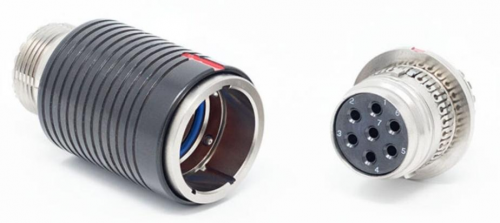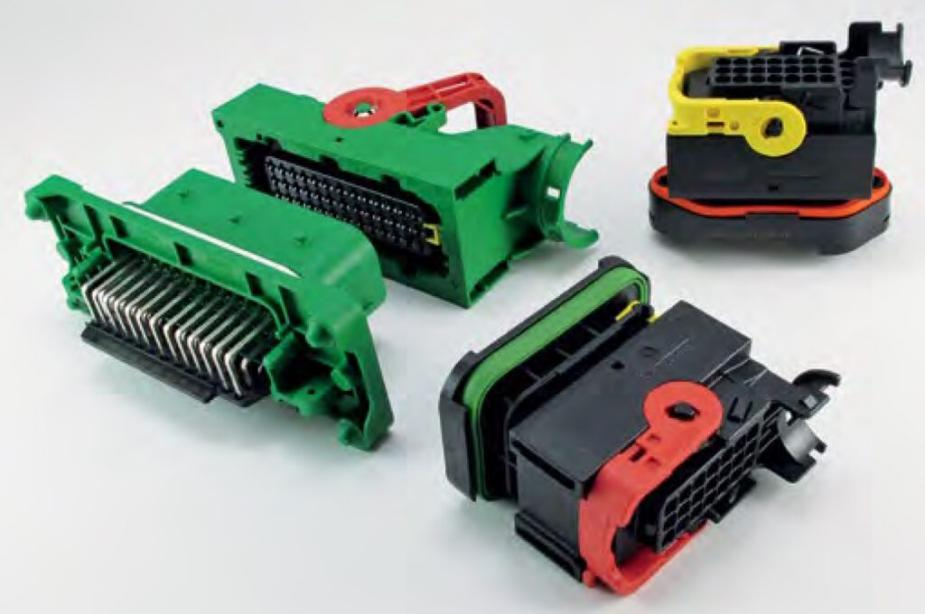There are various locking mechanisms on connectors, including bayonet, latch, lever, push-pull, screw, and snap-in. These represent the more common styles, but are not an exhaustive list. Locking connectors can support a variety of functions, such as assisting with coupling and uncoupling and improving the environmental durability of the connection, in addition to enhancing mechanical performance and preventing accidental uncoupling.
Bayonet locks have a plug or pin on one half of the connector and a socket or hole on the other half. They are operated by aligning the two halves, pushing them together, and rotating the collar until you hear a click. Usually only 1/3 of a turn is needed to connect or disconnect them. Bayonet locks are used in circular connectors for power, signal, or RF contacts and are resistant to shock and vibration.
Latch
Latches use a spring compression mechanism to prevent the two halves of a connector from separating or moving relative to each other. Depending on the design, the connector needs to be pulled, pressed, or rotated to release the two halves. Spring latches in circular connectors are often made with steel springs to facilitate quick coupling in the field and support high mating cycles. Latches in rectangular connectors are often simpler plastic latches for low-cost applications that require minimal mating cycles.
Lever lock
Some rectangular connectors use an external clamping mechanism instead of an internal one. These designs are more robust than simple latch locks. In a typical design, one half has a lever arm that fits into a groove on the other half (Figure 1). Moving the lever connects the two halves together, and the connection is usually accompanied by an audible click. Lever locks are highly resistant to shock and vibration and are often used in applications such as industrial equipment and transportation systems.

Figure 1: Horizontal-lock connectors provide a more secure connection than simple latch locking. (Image courtesy of TE Connectivity)
Push-pull lock
Push-pull locking is sometimes also called push-fit or push-locking. When the two halves are pressed together and inserted into matching grooves in the receptacle, an internal latch in the plug retracts. When the two halves are locked together, a simple pull will not accidentally disconnect them (Figure 2). Disconnection requires squeezing the connector body while pulling the two halves apart. Some designs require twisting and squeezing the connector body for added security. The simplicity of these designs supports small solutions. Push-pull locking is used in applications such as medical systems where multiple quick connections and disconnections are required and accidental disconnections are extremely undesirable. They are also used in soldier-worn equipment and battery terminal connections.

Figure 2: Push-pull locking connectors are used in healthcare, soldier wear and similar applications. (Image courtesy of Amphenol)
Screw locking
Screw locking uses a threaded coupling that adds improved environmental protection to the shock and vibration performance of a bayonet lock. Circular connectors use a different screw locking design than rectangular connectors. With circular connectors, the threads are on both halves of the connector. Some rectangular connectors use a central screw on one half of the connector and a corresponding socket on the other half. These connectors often use guide pins to align the two halves. Other types of rectangular connectors, such as D-subminiature backshells, use a jack screw mechanism with jack screws on both sides of the backshell and threads in the panel connector for inserting the jack screws.
Snap-in locking
Snap-in latches, also known as snap-on or slide-on latches, are simple, low-cost, and compact. They snap together with relatively little force and pull apart just as easily. This can be an advantage or disadvantage, depending on the application. They connect quickly, but minimal holding strength can result in a higher risk of accidental disconnection compared to other latching methods such as push-pull latches. Snap-in latches are not suitable for applications such as healthcare, but rather for applications such as electrical test equipment where fast and frequent connection and decoupling are required and compact design is beneficial.
Summary
There are many different types of connector locking mechanisms. They provide varying degrees of secure connections, and some are more complex to implement than others. Different designs have been optimized for a range of application needs, from communications connections to industrial, military, healthcare, and test and measurement systems.










